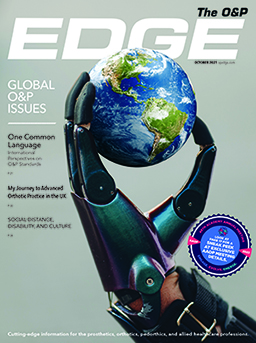Utah Array Enables Proprioception and Sensation
November 30, 2017
Researchers at the University of Utah have used the Utah Slanted Electrode Array (USEA), an implantable neural interface, to provide five degrees of freedom and the ability to perceive up to 131 proprioceptive and touch-based hand sensations, or percepts, to two human participants. The USEA was developed at the university as part of the Defense Advanced Research Projects Agency (DARPA) Hand Proprioception and Touch Interfaces (HAPTIX) program. The USEA allowed sensation to be transmitted back to the participants' nervous systems, creating a looped system in which the hand's feeling and movements inform each other as an intact hand would.
A Utah Slanted Electrode Array.
Photograph courtesy of Oregon State University.
"We often think of touch as one thing, but it's more than that. It's pressure, vibration, temperature, pain," Gregory Clark, PhD, told The Washington Post. Clark, a bioengineering associate professor at the university, leads the research team.
Intuitive control of prostheses and their ability to provide sensory feedback has been limited to three degrees of freedom with two sensory percepts in closed-loop control. The USEA has been previously used to provide up to 81 sensory percepts for people with amputations; the latest study reports on the advanced capabilities of multiple USEAs implanted in the residual nerves of each participant's peripheral arm. The study, published November 25 in the Journal of NeuroEngineering and Rehabilitation, also demonstrated that USEA-restored sensory percepts provide a useful source of feedback during closed-loop virtual prosthetic hand control.
Two 100-channel USEAs were implanted for four to five weeks, one each in the median and ulnar arm nerves of two human subjects with long-term upper-arm amputations. According to the study, intended finger and wrist positions were decoded from neuronal firing patterns via a modified Kalman filter, which allowed subjects to control many movements of a virtual prosthetic hand. Additionally, USEA microstimulation was used to evoke numerous sensory percepts spanning the phantom hand. Closed-loop control was achieved by stimulating via an electrode of the ulnar-nerve USEA while recording and decoding movement via the median-nerve USEA.
The subjects controlled up to 12 degrees of freedom during informal, freeform online movement decode sessions, and experienced up to 131 USEA-evoked proprioceptive and cutaneous sensations spanning the phantom hand. Independent control was achieved for a five-degree-of-freedom, real-time decode that included flexion/extension of the thumb, index, middle, and ring fingers, and the wrist. Proportional control was achieved for a four-degree-of-freedom, real-time decode. One subject used a USEA-evoked hand sensation as feedback to complete a one-degree-of-freedom, closed-loop, virtual-hand movement task. There were no observed long-term functional deficits due to the USEA implants, according to the authors.
Future use of the USEA in longer-term implants and in closed loops may enable restoration of many of the capabilities of an intact hand, while contributing to a meaningful embodiment of the prosthesis. Research has shown that embodiment of a prosthesis may reduce prosthesis rejection rates, alleviate phantom limb pain, and contribute to a restored sense of well-being and completeness.






-
-
-
-
CONTACT US